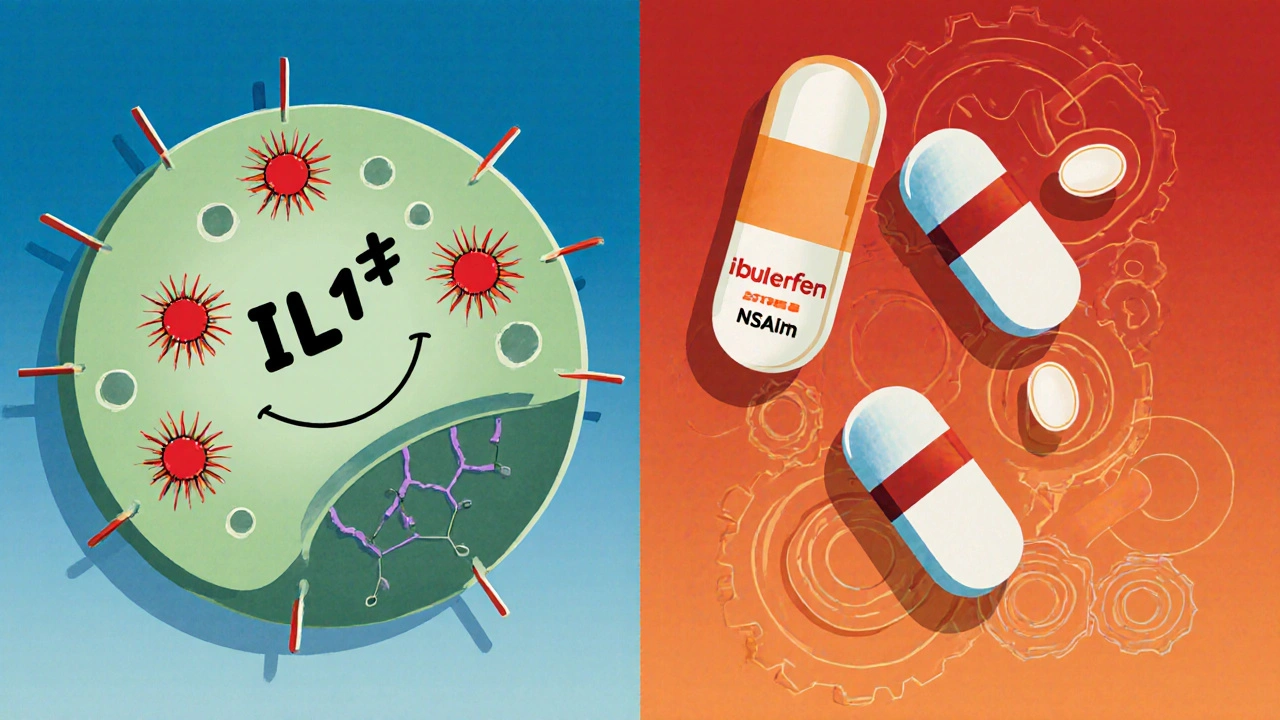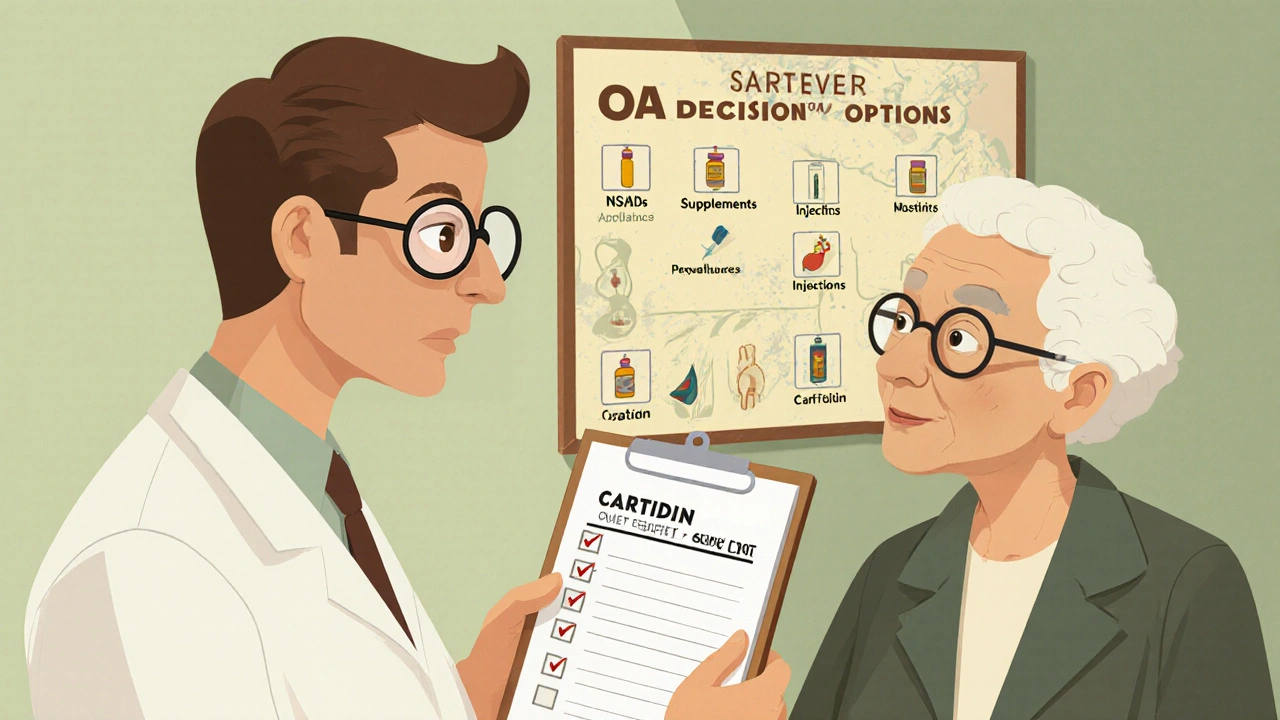Osteoarthritis Treatment Selector
Find Your Best Osteoarthritis Treatment
This tool helps you select the most appropriate osteoarthritis treatment based on your specific priorities and health conditions. Answer a few simple questions to get personalized recommendations.
Anyone dealing with knee or hip osteoarthritis knows the endless stream of medication options. Cartidin (the brand name for diacerein) often pops up, but how does it really stack up against the more familiar NSAIDs or the newer nutraceuticals? This guide walks you through the science, dosing, efficacy, and cost of Cartidin and its most common rivals, so you can decide which route makes sense for a specific patient or yourself.
What is Cartidin (Diacerein)?
Cartidin (Diacerein) is a disease‑modifying osteoarthritis drug (DMOAD) that aims to slow cartilage breakdown rather than just mask pain. It was first approved in several European countries in the early 2000s and is available in tablet form (50 mg). The active ingredient, diacerein, is a derivative of anthraquinone, extracted from the roots of Rheum palmatum (Chinese rhubarb).
How does diacerein work?
Unlike NSAIDs that block cyclo‑oxygenase enzymes to reduce inflammation, diacerein targets interleukin‑1β (IL‑1β), a cytokine that accelerates cartilage degradation. By inhibiting IL‑1β, diacerein may reduce the release of matrix‑metalloproteinases (MMPs) and promote the synthesis of proteoglycans-key building blocks of healthy cartilage. Clinical trials from 2015‑2020 showed modest improvements in WOMAC scores (Western Ontario and McMaster Universities Arthritis Index) after 12‑weeks of treatment, especially in patients with mild‑to‑moderate disease.
Typical dosing and safety profile
- Standard dose: 50 mg twice daily with meals.
- Maximum duration: 3 months, followed by a 2‑month drug‑free interval to limit gastrointestinal side effects.
- Most common adverse events: loose stools, abdominal pain, and occasional rash.
- Contraindications: severe liver disease, active peptic ulcer, and pregnancy.
Because diacerein is metabolized in the liver, baseline liver function tests are recommended before starting therapy and repeated after 4‑6 weeks.

Alternative osteoarthritis treatments
When you weigh Cartidin against other options, the field splits into three buckets: classic NSAIDs, injectable therapies, and nutraceuticals.
- Ibuprofen - a short‑acting NSAID taken 200‑400 mg every 4-6 hours.
- Diclofenac - longer‑acting NSAID, 50 mg two to three times daily.
- Naproxen - 250‑500 mg twice daily, good for patients needing 12‑hour coverage.
- Glucosamine (typically 1500 mg daily) - a nutraceutical thought to support cartilage health.
- Chondroitin (800 mg daily) - often paired with glucosamine for synergistic effect.
- Hyaluronic acid injections - intra‑articular gel administered once a month for knee OA.
- Corticosteroid injections - powerful short‑term pain relief, limited to 3‑4 injections per year.
- Duloxetine - a serotonin‑norepinephrine reuptake inhibitor (SNRI) approved for chronic musculoskeletal pain.
Head‑to‑head comparison
| Attribute | Cartidin (Diacerein) | Ibuprofen (NSAID) | Diclofenac (NSAID) | Glucosamine | Hyaluronic Acid Injection |
|---|---|---|---|---|---|
| Mechanism | IL‑1β inhibition, cartilage‑protective | COX‑1/COX‑2 inhibition, analgesic | Selective COX‑2 inhibition, analgesic | Provides building blocks for proteoglycans | Visco‑supplementation, mechanical shock absorption |
| Typical dose | 50 mg × 2/day | 200‑400 mg × 3‑4/day | 50 mg × 2‑3/day | 1500 mg × 1/day | 20‑30 mg intra‑articular, once/month |
| Onset of relief | 4‑6 weeks | 30‑60 minutes | 30‑60 minutes | 4‑12 weeks (variable) | 1‑2 weeks after injection series |
| Efficacy (WOMAC reduction) | ≈10‑15 % vs. baseline | ≈20‑25 % vs. baseline | ≈22‑27 % vs. baseline | ≈5‑10 % vs. baseline | ≈15‑20 % vs. baseline |
| Common side effects | Diarrhea, abdominal pain, liver enzyme rise | Gastric irritation, ulcer risk | Cardiovascular risk, liver toxicity | Minimal GI upset | Joint swelling, transient pain |
| Cost (US, average monthly) | $80‑$120 | $15‑$30 | $30‑$45 | $40‑$70 | $300‑$400 (per injection series) |
| Regulatory status (US) | Not FDA‑approved; available via compounding pharmacies | OTC | Prescription | OTC | Prescription (specialty) |

When to choose Cartidin over other options
Because diacerein works slower but targets disease progression, it fits a particular niche:
- Patients with chronic mild‑to‑moderate OA who can tolerate a 3‑month trial and prefer a drug that may protect cartilage.
- Those at high GI risk (e.g., history of ulcer, concurrent anticoagulants) where NSAIDs pose a bigger danger.
- Individuals who have exhausted NSAIDs due to cardiovascular or renal concerns.
- People seeking a non‑opioid option that isn’t purely symptomatic.
Conversely, if rapid pain relief is the primary goal, short‑acting NSAIDs or a corticosteroid injection will win out. For patients who are cost‑sensitive, the OTC NSAIDs are dramatically cheaper, while hyaluronic acid injections usually require insurance pre‑approval.
Practical checklist for clinicians
- Confirm diagnosis of knee/hip OA with radiographs.
- Review liver function, GI history, and cardiovascular risk.
- If diacerein is chosen, start at 50 mg twice daily with meals.
- Re‑check ALT/AST after 4 weeks; discontinue if >3× ULN.
- Schedule a drug‑free interval after 3 months; assess pain and functional scores.
- Document why diacerein was selected over NSAIDs (e.g., GI safety, disease‑modifying intent).
Bottom line
Cartidin (diacerein) offers a unique disease‑modifying angle that most NSAIDs lack, but its slower onset, GI side effects, and lack of FDA approval in the U.S. limit widespread use. For patients who can handle the monitoring and want a potential cartilage‑sparing option, it’s a viable alternative to long‑term NSAID therapy. Otherwise, traditional NSAIDs, nutritional supplements, or intra‑articular injections remain the go‑to choices.
Is Cartidin approved for use in the United States?
No. Diacerein is not FDA‑approved. It can be obtained only through compounding pharmacies under a physician’s prescription, and its use is off‑label.
How long does it take to see benefits from Cartidin?
Clinical studies report noticeable improvements in pain and function after 4‑6 weeks of consistent dosing, but full effects may require a 12‑week course.
Can Cartidin be combined with NSAIDs?
Co‑administration is generally discouraged because both drugs can irritate the GI mucosa. If short‑term NSAID relief is needed, stagger the doses and consider a proton‑pump inhibitor.
What are the main side effects to watch for?
The most frequent adverse events are loose stools, abdominal cramps, and a modest rise in liver enzymes. Rarely, severe diarrhea can lead to dehydration; patients should stay hydrated and report persistent GI distress.
Is diacerein suitable for older adults?
Older adults may benefit from the reduced GI risk compared with NSAIDs, but clinicians must monitor liver function closely. Dose adjustment is rarely needed, but the drug‑free interval after three months is crucial.


Danielle St. Marie
October 23, 2025 AT 14:13Honestly, Cartidin feels like a boutique supplement only the European elite can afford 🤨💸. If you’re looking for a legit disease‑modifying option, you better be ready to pay the premium and endure the GI drama. The drug’s lack of FDA approval makes it a fringe experiment rather than mainstream therapy. And let’s not forget, you’re basically trusting a rhubarb extract to save your joints. 🇺🇸
keerthi yeligay
October 23, 2025 AT 14:46hey dont be to hard on diacerein its actually kinda cool
it targets il‑1β which is a deep root cause so it can help if you stick to the plan
Bonnie Lin
October 23, 2025 AT 16:10Cartidin can be a good option for patients who can’t tolerate NSAIDs the GI risk is lower for many
just keep an eye on liver tests and you’ll be fine
sara fanisha
October 23, 2025 AT 17:33Totally agree – it’s nice to have something that isn’t just masking pain. If you can wait a few weeks for the effect, the cartilage‑saving angle is worth it! 🌟
Tristram Torres
October 23, 2025 AT 18:56Honestly, why bother with some obscure drug when ibuprofen works in minutes? The whole diacerein thing just sounds like a marketing ploy. Most people need quick relief, not a slow‑poke experiment.
Jinny Shin
October 23, 2025 AT 20:20Oh, the drama! You think Cartidin is just another pill? No, darling, it’s a statement – a bold declaration that you refuse to settle for temporary fixes. Its elegance lies in the subtle art of cartilage preservation, a true masterpiece for the discerning patient.
Abhishek Kumar
October 23, 2025 AT 21:43Sounds like a pricey gamble.
hema khatri
October 23, 2025 AT 23:06Listen up! If you’re an American and care about your health, you should demand Cartidin be approved here!!! No more waiting for foreign compounding, we deserve the best, period!!!
Jennell Vandermolen
October 24, 2025 AT 00:30while it’s understandable to want wider access, it’s important to follow safety protocols like liver monitoring before pushing for approval
Mike Peuerböck
October 24, 2025 AT 01:53Esteemed colleagues, let us consider the broader pharmacoeconomic landscape. Cartidin’s modest efficacy, juxtaposed with its higher cost, may pose adherence challenges for patients of modest means. However, its potential to attenuate cartilage degradation could translate into reduced surgical interventions over a decade, a prospect that merits serious contemplation.
Simon Waters
October 24, 2025 AT 03:16Sure, but have you thought about the hidden agenda? Big pharma pushes NSAIDs so they can keep profits high while keeping us away from real solutions like diacerein.
Celeste Flynn
October 24, 2025 AT 04:40Diacerein, marketed as Cartidin, occupies a unique niche in the therapeutic armamentarium for osteoarthritis, aiming to modify disease progression rather than merely palliate symptoms. Its mechanism hinges on the inhibition of interleukin‑1β, a pivotal cytokine in the catabolic cascade that accelerates cartilage breakdown. By dampening this pathway, diacerein reduces matrix‑metalloproteinase activity, thereby preserving the structural integrity of the joint. Clinical trials spanning 2015 to 2020 have demonstrated modest yet statistically significant improvements in WOMAC scores after a 12‑week regimen, particularly among patients with mild-to-moderate disease severity. The dosing schedule is straightforward: 50 mg taken twice daily with meals, administered for a maximum of three months followed by a two‑month drug‑free interval to mitigate gastrointestinal adverse effects. Common side effects include loose stools, abdominal discomfort, and occasional rash, all of which are generally self‑limiting. Liver function monitoring is imperative, as diacerein undergoes hepatic metabolism and may elevate transaminases in susceptible individuals. Compared with NSAIDs, Cartidin offers a reduced risk of gastric ulceration, making it an attractive option for patients with a history of peptic disease or concurrent anticoagulant therapy. However, the slower onset of analgesia-typically 4–6 weeks-contrasts starkly with the rapid pain relief afforded by ibuprofen or diclofenac within an hour of dosing. Cost considerations are also salient; monthly expenses for Cartidin range from $80 to $120, substantially higher than over‑the‑counter NSAIDs but lower than the $300‑$400 associated with hyaluronic acid injection series. Because the drug is not FDA‑approved, access in the United States is limited to compounding pharmacies, necessitating a prescriber’s endorsement and off‑label use documentation. In clinical practice, Cartidin is best reserved for patients who prioritize long‑term joint preservation, have contraindications to NSAIDs, or have exhausted conventional analgesic options without satisfactory outcomes. For those requiring immediate pain control, NSAIDs or intra‑articular corticosteroids remain the preferred modalities. Ultimately, the decision to incorporate Cartidin into a treatment plan should balance its disease‑modifying potential against the logistical and financial constraints inherent to its use.
Shan Reddy
October 24, 2025 AT 06:03Thanks for the thorough rundown. I’ll keep the liver checks in mind if I ever consider it.
CASEY PERRY
October 24, 2025 AT 07:26The pharmacodynamic profile of diacerein suggests a modestly favorable risk‑benefit ratio in the subset of patients with chronic mild‑to‑moderate OA, particularly when concomitant NSAID therapy is contraindicated.
Naomi Shimberg
October 24, 2025 AT 08:50While the data may appear compelling, one must question the underlying motives of promoting yet another “alternative” when the established analgesics already dominate the market. The narrative surrounding Cartidin often feels contrived, as if to challenge the status quo without sufficient empirical justification.